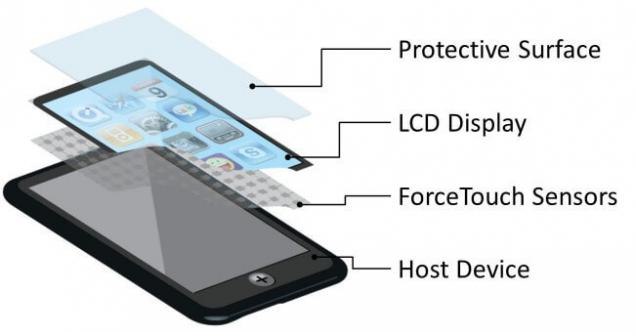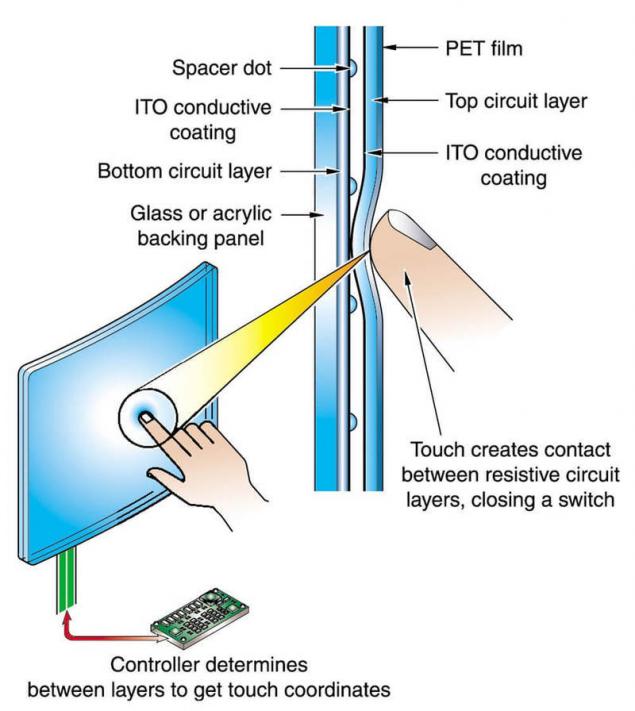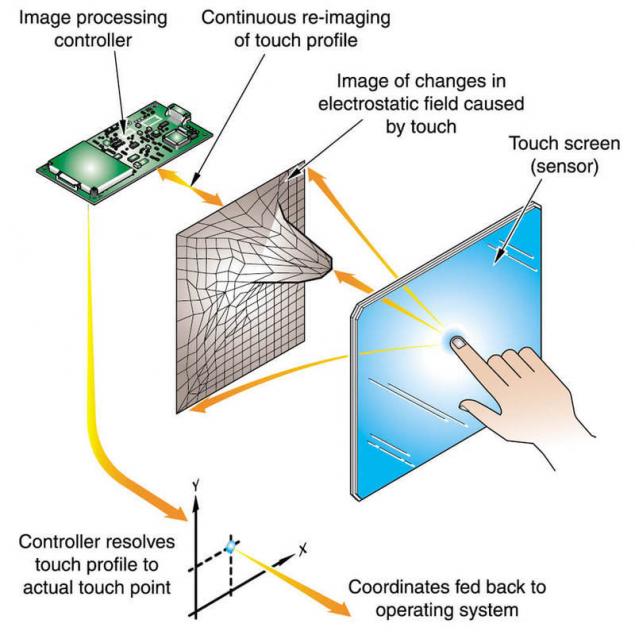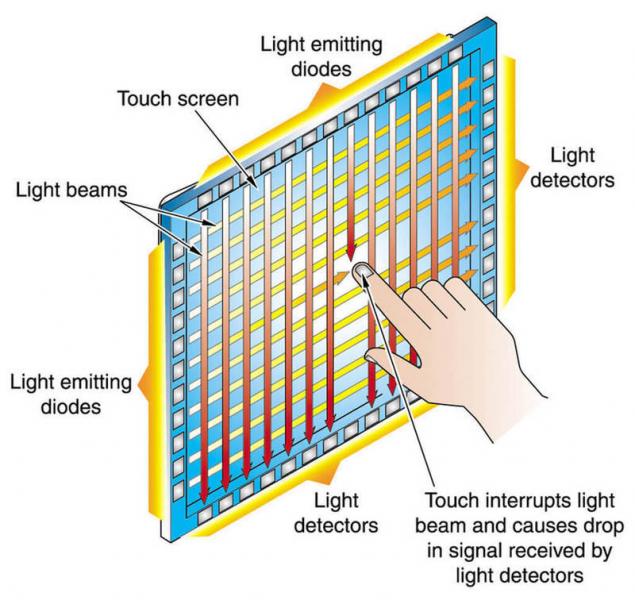979
The principle of operation of touchscreens
First touch screens (touch screens) are extremely rare. They can be found mainly only in some handheld computers (PDAs, PDA). As is known, these devices have not received wide distribution, because they lacked the most important: the functionality of the phone.
The history of smartphones is closely linked with the touchscreen. And so modern man with a "smart phone" in my pocket, touch screen can not be surprised. The touchscreen is widely used in fashion expensive devices and even relatively cheap phones.

But we will not again discuss the advantages and shortcomings of these or those phone models. In this issue, each user is able to decide for themselves.
Let's talk about the principles of operation three types of touch screens that you can find in a modern device.
So touch screens has ceased to be too expensive. In addition, the touchscreen became much more "responsive" and touch user now recognize perfectly. This made them a broad road for the masses of users.
Currently, there are three basic designs of touch screens:
1.Resistive or simply "elastic" (Resistive)
2.Capacitive (Capacitive)
3.Wave (Surface acoustic wave)
About the resistive touchscreen. The recent past

Resistive system consists of a normal glass, coated with a layer of conductor metal and an elastic "tape", also having conductive properties. Between these two layers by means of special spacers to leave an empty space. And the screen surface is covered with material that protects it from scratches.
During the user experience with touch, an electrical charge passes through both layers.
How is everything going? The user touches the screen at a certain point and elastic top layer comes in contact with provodnikovym layer. And it is at this point. The computer then determines the coordinates of a point touched by a user.
When the coordinates of the already known device, a special driver translates the touch into a known operating system commands. Here an analogy with the driver of a conventional computer mouse. He was doing the same: operating system explains exactly what he wanted her to tell the user pressing a button or the movement of the manipulator. With screens of this type often use a special stylus.
Resistive screens can be detected in relatively elderly devices. It was such a touch screen was equipped with the IBM Simon, the oldest of our civilization, smartphones.
Device capacitive screen. Digital now

The touchscreen of this design glass base covered with a layer playing the role of containers-storage of electrical charge. His touch, the user releases the part of the electric charge at a certain point. This reduction is determined by the chips located in each of the corners of the screen. The computer calculates the difference of electric potential between different parts of the screen and touch all the details immediately transmitted to a driver of a touchscreen.
An important advantage of capacitive touchscreens is the ability of this type of screens to retain almost 90% of the original brightness of the display. The screens are resistive type retained only about 75% of the initial light. For this reason, the image on the capacitive screen looks much clearer than the resistive touchscreen design.
Wave-touch displays. Bright future

At the ends of the X and Y axes of a grid glass screen is Converter. One of them is transmitting and the second receiving. Glass-based reflectors are "reflecting" an electrical signal that is passed from one drive to another.
The transducer-receiver just "knows" there was a depression and at what point it happened, because by his touch the user makes the break in the acoustic wave. Glass wave display is devoid of the metallic coating that allows you to keep 100% of the initial light.
Due to its less pleasant features, the wave screen is the best choice for users working in small graphic details. Because resistive and capacitive touchscreens are not ideal in terms of image clarity. The coating delays the light and distorts the picture.
Some of the features of the different touchscreens
The cheapest and least clearly transmitting picture touch screens are resistive. In addition, they are also the most vulnerable. Any sharp object can damage the delicate resistive "film".
Wave touchscreens are the most expensive among their own kind.
Resistive design rather refers to the past, wave of the future and a capacitive — to the present. Although no one knows the future and can only assume that technology has some prospects.
For the resistive system does not matter, touched the screen with a rubber tipped stylus or finger. It is enough that the two layers come in contact.
Capacitive screen only recognizes the touch a conductive object. Most often, users work with them with his fingers.
In this respect, the design of the wave screens closer to resistive. Give it the command can be almost any object, while avoiding too heavy and small objects. That is, the rod of a ballpoint pen will not work.published
Also interesting: the New development will allow smartphones to charge while scrolling
The Quick Charge 4 charge the phone for five minutes
P. S. And remember, only by changing their consumption — together we change the world! ©
Source: masterok.livejournal.com/3319202.html
The history of smartphones is closely linked with the touchscreen. And so modern man with a "smart phone" in my pocket, touch screen can not be surprised. The touchscreen is widely used in fashion expensive devices and even relatively cheap phones.

But we will not again discuss the advantages and shortcomings of these or those phone models. In this issue, each user is able to decide for themselves.
Let's talk about the principles of operation three types of touch screens that you can find in a modern device.
So touch screens has ceased to be too expensive. In addition, the touchscreen became much more "responsive" and touch user now recognize perfectly. This made them a broad road for the masses of users.
Currently, there are three basic designs of touch screens:
1.Resistive or simply "elastic" (Resistive)
2.Capacitive (Capacitive)
3.Wave (Surface acoustic wave)
About the resistive touchscreen. The recent past

Resistive system consists of a normal glass, coated with a layer of conductor metal and an elastic "tape", also having conductive properties. Between these two layers by means of special spacers to leave an empty space. And the screen surface is covered with material that protects it from scratches.
During the user experience with touch, an electrical charge passes through both layers.
How is everything going? The user touches the screen at a certain point and elastic top layer comes in contact with provodnikovym layer. And it is at this point. The computer then determines the coordinates of a point touched by a user.
When the coordinates of the already known device, a special driver translates the touch into a known operating system commands. Here an analogy with the driver of a conventional computer mouse. He was doing the same: operating system explains exactly what he wanted her to tell the user pressing a button or the movement of the manipulator. With screens of this type often use a special stylus.
Resistive screens can be detected in relatively elderly devices. It was such a touch screen was equipped with the IBM Simon, the oldest of our civilization, smartphones.
Device capacitive screen. Digital now

The touchscreen of this design glass base covered with a layer playing the role of containers-storage of electrical charge. His touch, the user releases the part of the electric charge at a certain point. This reduction is determined by the chips located in each of the corners of the screen. The computer calculates the difference of electric potential between different parts of the screen and touch all the details immediately transmitted to a driver of a touchscreen.
An important advantage of capacitive touchscreens is the ability of this type of screens to retain almost 90% of the original brightness of the display. The screens are resistive type retained only about 75% of the initial light. For this reason, the image on the capacitive screen looks much clearer than the resistive touchscreen design.
Wave-touch displays. Bright future

At the ends of the X and Y axes of a grid glass screen is Converter. One of them is transmitting and the second receiving. Glass-based reflectors are "reflecting" an electrical signal that is passed from one drive to another.
The transducer-receiver just "knows" there was a depression and at what point it happened, because by his touch the user makes the break in the acoustic wave. Glass wave display is devoid of the metallic coating that allows you to keep 100% of the initial light.
Due to its less pleasant features, the wave screen is the best choice for users working in small graphic details. Because resistive and capacitive touchscreens are not ideal in terms of image clarity. The coating delays the light and distorts the picture.
Some of the features of the different touchscreens
The cheapest and least clearly transmitting picture touch screens are resistive. In addition, they are also the most vulnerable. Any sharp object can damage the delicate resistive "film".
Wave touchscreens are the most expensive among their own kind.
Resistive design rather refers to the past, wave of the future and a capacitive — to the present. Although no one knows the future and can only assume that technology has some prospects.
For the resistive system does not matter, touched the screen with a rubber tipped stylus or finger. It is enough that the two layers come in contact.
Capacitive screen only recognizes the touch a conductive object. Most often, users work with them with his fingers.
In this respect, the design of the wave screens closer to resistive. Give it the command can be almost any object, while avoiding too heavy and small objects. That is, the rod of a ballpoint pen will not work.published
Also interesting: the New development will allow smartphones to charge while scrolling
The Quick Charge 4 charge the phone for five minutes
P. S. And remember, only by changing their consumption — together we change the world! ©
Source: masterok.livejournal.com/3319202.html
Honda will introduce a new hybrid vehicle in 2018
Programmable thermostat – the key to saving money on home heating























